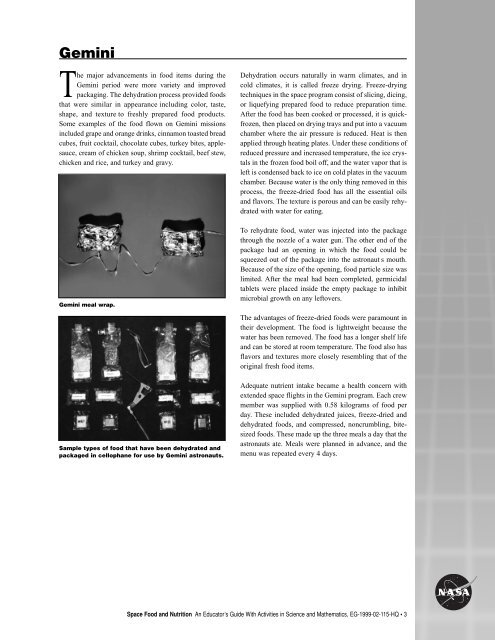Space Food and Nutrition pdf - Virtual Astronaut
Space Food and Nutrition pdf - Virtual Astronaut
Space Food and Nutrition pdf - Virtual Astronaut
- No tags were found...
You also want an ePaper? Increase the reach of your titles
YUMPU automatically turns print PDFs into web optimized ePapers that Google loves.
GeminiThe major advancements in food items during theGemini period were more variety <strong>and</strong> improvedpackaging. The dehydration process provided foodsthat were similar in appearance including color, taste,shape, <strong>and</strong> texture to freshly prepared food products.Some examples of the food flown on Gemini missionsincluded grape <strong>and</strong> orange drinks, cinnamon toasted breadcubes, fruit cocktail, chocolate cubes, turkey bites, applesauce,cream of chicken soup, shrimp cocktail, beef stew,chicken <strong>and</strong> rice, <strong>and</strong> turkey <strong>and</strong> gravy.Gemini meal wrap.Sample types of food that have been dehydrated <strong>and</strong>packaged in cellophane for use by Gemini astronauts.Dehydration occurs naturally in warm climates, <strong>and</strong> incold climates, it is called freeze drying. Freeze-dryingtechniques in the space program consist of slicing, dicing,or liquefying prepared food to reduce preparation time.After the food has been cooked or processed, it is quickfrozen,then placed on drying trays <strong>and</strong> put into a vacuumchamber where the air pressure is reduced. Heat is thenapplied through heating plates. Under these conditions ofreduced pressure <strong>and</strong> increased temperature, the ice crystalsin the frozen food boil off, <strong>and</strong> the water vapor that isleft is condensed back to ice on cold plates in the vacuumchamber. Because water is the only thing removed in thisprocess, the freeze-dried food has all the essential oils<strong>and</strong> flavors. The texture is porous <strong>and</strong> can be easily rehydratedwith water for eating.To rehydrate food, water was injected into the packagethrough the nozzle of a water gun. The other end of thepackage had an opening in which the food could besqueezed out of the package into the astronaut s mouth.Because of the size of the opening, food particle size waslimited. After the meal had been completed, germicidaltablets were placed inside the empty package to inhibitmicrobial growth on any leftovers.The advantages of freeze-dried foods were paramount intheir development. The food is lightweight because thewater has been removed. The food has a longer shelf life<strong>and</strong> can be stored at room temperature. The food also hasflavors <strong>and</strong> textures more closely resembling that of theoriginal fresh food items.Adequate nutrient intake became a health concern withextended space flights in the Gemini program. Each crewmember was supplied with 0.58 kilograms of food perday. These included dehydrated juices, freeze-dried <strong>and</strong>dehydrated foods, <strong>and</strong> compressed, noncrumbling, bitesizedfoods. These made up the three meals a day that theastronauts ate. Meals were planned in advance, <strong>and</strong> themenu was repeated every 4 days.<strong>Space</strong> <strong>Food</strong> <strong>and</strong> <strong>Nutrition</strong> An Educator’s Guide With Activities in Science <strong>and</strong> Mathematics, EG-1999-02-115-HQ • 3
















